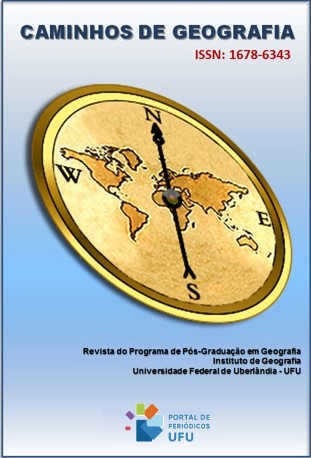VARIAÇÃO ESPAÇO-TEMPORAL (1981-2020) DA CHUVA NA REGIÃO COSTEIRA DO ESTADO DO PARÁ – AMAZÔNIA ORIENTAL
DOI:
https://doi.org/10.14393/RCG259970567Palavras-chave:
Geotecnologia, Precipitação, Litoral, AmazôniaResumo
A região costeira do Pará é caracterizada pelo maior índice pluviométrico do estado. Atualmente as representações da variabilidade das chuvas estão predominantemente baseadas em dados de estações meteorológicas de superfície, promovendo uma confiança limitada para estudos sobre a variabilidade da chuva local. Neste contexto, propõem-se analisar a variabilidade da chuva para a região costeira do Pará, utilizando dados de sensoriamento remoto. O estudo apresenta a aplicação da técnica do produto de sensoriamento remoto, disponibilizado pelo Climate Hazards Group InfraRed Precipitation with Stations (CHIRPS) com base nas estimativas e dados de alta resolução espacial e temporal. A variabilidade espaço-temporal da chuva foi representada pela climatologia anual, sazonal e mensal, e relacionada aos sistemas e mecanismos oceano-atmosfera que favorecem a precipitação local. A variabilidade anual mostrou que as chuvas apresentam distribuição distintas em anos de ocorrência do mecanismo ENOS. Na escala sazonal os dados elucidaram a sazonalidade regional com maiores acumulados de chuvas durante o verão e outono. Na escala mensal as chuvas ficaram distribuídas principalmente na porção norte da área durante os primeiros meses do ano. Este conhecimento torna-se uma ferramenta alternativa e eficaz para o gerenciamento costeiro, corroborando para estudos de modelagem e permitindo sua replicação para outras áreas.
Downloads
Downloads
Publicado
Edição
Seção
Licença
Copyright (c) 2024 Marcos Ronielly Silva Santos, Eder Mileno Silva de Paula, Davi Rodrigues Rabelo, Marcia Aparecida da Silva Pimentel

Este trabalho está licenciado sob uma licença Creative Commons Attribution-NonCommercial-NoDerivatives 4.0 International License.
Autores que publicam nesta revista concordam com os seguintes termos: a) Autores mantém os direitos autorais e concedem à revista o direito de primeira publicação, com o trabalho licenciado sob a Creative Commons Atribuição-NãoComercial-SemDerivações 4.0 Internacional. b) Autores têm permissão e são estimulados a publicar e distribuir seu trabalho online (ex.: em repositórios institucionais ou na sua página pessoal), já que isso pode gerar alterações produtivas, bem como aumentar o impacto e a citação do trabalho publicado. c) Em virtude de aparecerem nesta revista de acesso público, os artigos são de uso gratuito, com atribuições próprias, em aplicações educacionais e não-comerciais.











